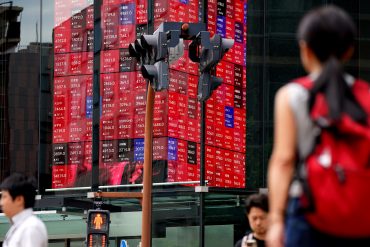
- Asia Markets
- Global Markets
- Semiconductors
Asian Stocks Slip Ahead of Nvidia Earnings and Fed Rate Outlook
5 minute read

Global tech stocks and semiconductor markets face pivotal test as Asian investors await Nvidia’s quarterly performance
Key Takeaways
- Asian markets decline ahead of Nvidia earnings – Most Asian stocks retreated with Japanese and South Korean markets dropping about 1% as investors prepare for the chipmaker’s crucial earnings report expected Wednesday
- Fading US rate cut optimism pressures tech stocks – Money markets price in 80% probability of September Fed rate cut, down from earlier expectations as core PCE inflation expected to show 2.9% annual rise
- China’s CSI 300 posts best week since November – Despite Tuesday’s 0.4% decline, Chinese stocks gained 2.1% for the week with technology and property sectors leading gains after Beijing stimulus expectations
Introduction
Asian stock markets face mounting pressure as investor optimism over imminent US interest rate cuts diminishes and technology shares brace for Nvidia’s pivotal earnings report. Most regional indices retreated Tuesday, with Japanese and South Korean markets leading declines of approximately 1% each.
The market downturn reflects growing caution among investors who are balancing hopes for easier monetary policy against mixed economic signals from the United States. Tech stocks remain particularly vulnerable ahead of Nvidia’s earnings release, which analysts view as a critical benchmark for the broader semiconductor sector.
Key Developments
Chinese markets experienced their first notable pullback after weeks of strong gains, with the Shanghai Shenzhen CSI 300 and Shanghai Composite indexes falling 0.4% and 0.3% respectively. The decline comes after expectations of economic relief from Beijing had previously bolstered shares to multi-year highs.
Japan’s Nikkei 225 and TOPIX indexes each dropped about 1%, while South Korea’s KOSPI posted similar losses. The retreat was primarily driven by technology stock sell-offs as investors position themselves ahead of Nvidia’s quarterly results.
Australia’s ASX 200 declined 0.3%, weighed down by mining sector losses. Fortescue Metals Group reported disappointing annual earnings, pressuring its shares down 1.6% and affecting peers including BHP Group and Rio Tinto.
Market Impact
The options market is pricing in a significant 5.82% swing in Nvidia shares following its earnings announcement, reflecting both high expectations and uncertainty about the company’s performance. Nvidia stock closed at $179.83, near its all-time high of $183.16 reached earlier this month.
Despite regional market weakness, Taiwan’s TSMC remained stable as investors await guidance on Nvidia’s operations in China and potential challenges with its H20 chip sales. The semiconductor giant’s resilience demonstrates selective investor confidence within the broader tech selloff.
US Treasury yields rose to 4.28% while the dollar strengthened, adding pressure to Asian assets. Money markets now assign an 80% probability to a September Federal Reserve rate cut, with expectations for two total reductions by year-end.
Strategic Insights
The current market dynamics highlight the technology sector’s sensitivity to both macroeconomic policy and individual company performance. Nvidia’s upcoming earnings serve as a bellwether for AI spending across the entire tech ecosystem, with implications extending beyond semiconductors to cloud computing and enterprise software.
Chinese technology companies face a complex environment as they benefit from domestic stimulus expectations while navigating ongoing geopolitical tensions. Local chipmakers have gained ground against global competitors, though this progress remains vulnerable to broader market sentiment shifts.
The mining sector’s weakness in Australia reflects broader concerns about global economic growth and commodity demand. Companies like Fortescue are experiencing pressure as investors reassess growth prospects amid mixed signals from major economies.
Expert Opinions and Data
Market analysts describe the current environment as a “battle” between bullish and bearish forces, particularly visible in Nvidia’s price action around technical levels of $179.94 and $172.53. Long-term investors focus on whether the company can maintain high earnings multiples through continued estimate revisions and fundamental strength.
The Federal Reserve’s preferred inflation gauge, the core PCE index, is anticipated to show an annual rise of 2.9%, marking the fastest pace in five months. This data could significantly influence Fed policy decisions and market expectations for rate cuts.
Despite Tuesday’s decline, China’s CSI 300 Index posted its best week since November with a 2.1% gain. Technology and property sectors led the advance as investors responded to stimulus expectations from Beijing authorities.
Conclusion
Asian markets reflect the broader challenge facing global investors as they navigate between technology sector leadership and macroeconomic uncertainty. The combination of fading rate cut optimism and high-stakes earnings reports creates a volatile environment for risk assets.
Current market positioning suggests investors remain selective, supporting established leaders like TSMC while showing caution toward broader sector exposure. The technology industry continues to drive market sentiment, with individual company results carrying outsized influence on regional and global indices.








